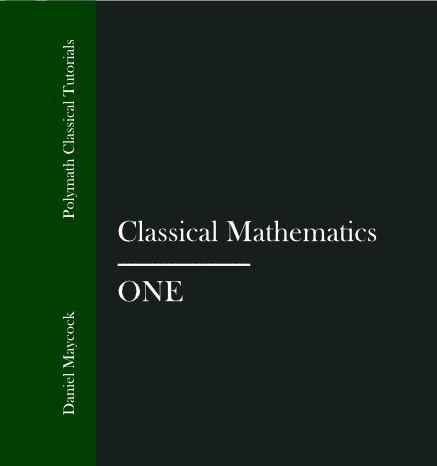Classical Mathematics
New to classical mathematics? Wondering how it’s different from “normal” math? Read What is Classical Mathematics? first.
Geometry
Learn geometry and precise thinking by reading Euclid’s Elements.
- 9th – 10th grade
- 31 weeks of lessons
- exam booklet
- detailed teacher guidebook
- companion videos
- also available as a live online course!
Algebra
Learn algebra by studying Greek and Renaissance thinkers.
- 9th – 11th grade
This course is still being developed. In the meantime, see our 6-week course in Diophantine Algebra.
Development Progress
(Progress last updated on 3/16/23)

Advanced Algebra
Learn algebra by reading the works of Descartes and others.
- 10th – 11th grade
This course is still being developed.
Development Progress

Advanced Algebra & Precalculus
Hone your math skills by reading Newton and Kepler.
- 11th – 12th grade
This course is still being developed.
Development Progress
Description
Classical Mathematics is an online four-year high school course which roughly follows standardized high school math curricula. In Classical Mathematics, students study and learn essentially the same mathematical concepts and processes as they would in standard high school textbooks. The difference is that Classical Mathematics is driven by primary sources (think a Great Books approach to math) and takes a (roughly) chronological approach to mathematical concepts.
High school students typically study math (and science, for that matter) by memorizing a series of processes and concepts without knowing where these processes and concepts came from. What students lose by studying math by this artificial approach are the philosophical and human elements. Mathematics is not the cold and unchanging discipline that high school texts present. Mathematics is a complex inquiry into the structure of rationality and the universe. The formulas and methods that textbooks casually present have rich histories and are often surprising solutions to difficult problems. When we study math in context and learn not only the solutions which we moderns have been handed, but also the questions which lead to them, we experience math in a different way. Math ceases to be merely an art of number tricks which allows us to balance our budgets and solve problems we’ll never encounter in ‘real life.’ Math itself comes to life, in much the same way that literature does.
Thus, the Classical Mathematics sequence solves several problems that plague students under contemporary math instruction:
- Memorizing formulas to pass tests rather than grasping the underlying concepts.
- Thinking that mathematics has nothing to do with other liberal arts (like philosophy or literature, for instance).
- Thinking that mathematics is a purely practical discipline which we must learn to solve problems––problems which we’ll probably never encounter.
- Not understanding that mathematics is a historical development in which perplexing problems lead to surprising discoveries, many of which explain the rules and formulas we use today.
Modern high school math is designed to lead students to calculus, so we’re designing Classical Mathematics to do the same. To put it another way, high school math aims at calculus (or precalculus), whereas Classical Mathematics leads students to Sir Isaac Newton’s Principia.
F. A. Q.
What is classical mathematics?
It’s a good question, and, as one might expect, the answer is a bit complicated. First, “classical mathematics” may be used to refer to a couple things. For instance, sometimes people will use the term “classical mathematics” to mean the mathematics developed during a culture’s “classical” age. For those of us in classical education, however, “classical” is more than a historical period.
How does the Classical Math curriculum compare with the scope and sequence of traditional textbooks?
Classical Math One (Geometry) is spent primarily in Euclid’s Elements, guiding students through the entirety of Books I, II, III, V, & VI.
Covered topics
- proofs & geometric logic
- geometric constructions
- properties of triangles, parallelograms (including squares & rectangles), circles
- congruence & similarity
- transformation of areas
- ratio & proportion
- Cartesian plane geometry
- Algebraic calculation of surfaces & areas
- Geometric solids
- Algebraic expressions of geometric principles (e.g. algebraic form of the Pythagorean theorem)
Classical Math Two (Algebra) is still in early development (see Diophantine Algebra in the meantime). However, it is being designed to roughly correspond to what is traditionally assigned to Algebra 1. In Classical Math Two, students will learn Algebra by studying the works of Greek (e.g. Diophantus) and early modern (e.g. Viete) mathematicians.
In Classical Math Three (Advanced Algebra) students will further their studies by studying the more advanced contributions of mathematicians like Descartes and others.
During Classical Math Four, students will begin to study Precalculus by way of Newton’s Principia.
Will my student learn real math, or is Classical Math just a history course?
Classical Mathematics is first and foremost a math course and only secondarily an “history of math” course. The historical aspect is a by-product. Students will learn real mathematical concepts & processes and work math problems, just like in any other mathematics curriculum. Students will learn math history by encountering math via primary texts, but the goal of the course is for students to study math within a Classical and Socratic approach.

